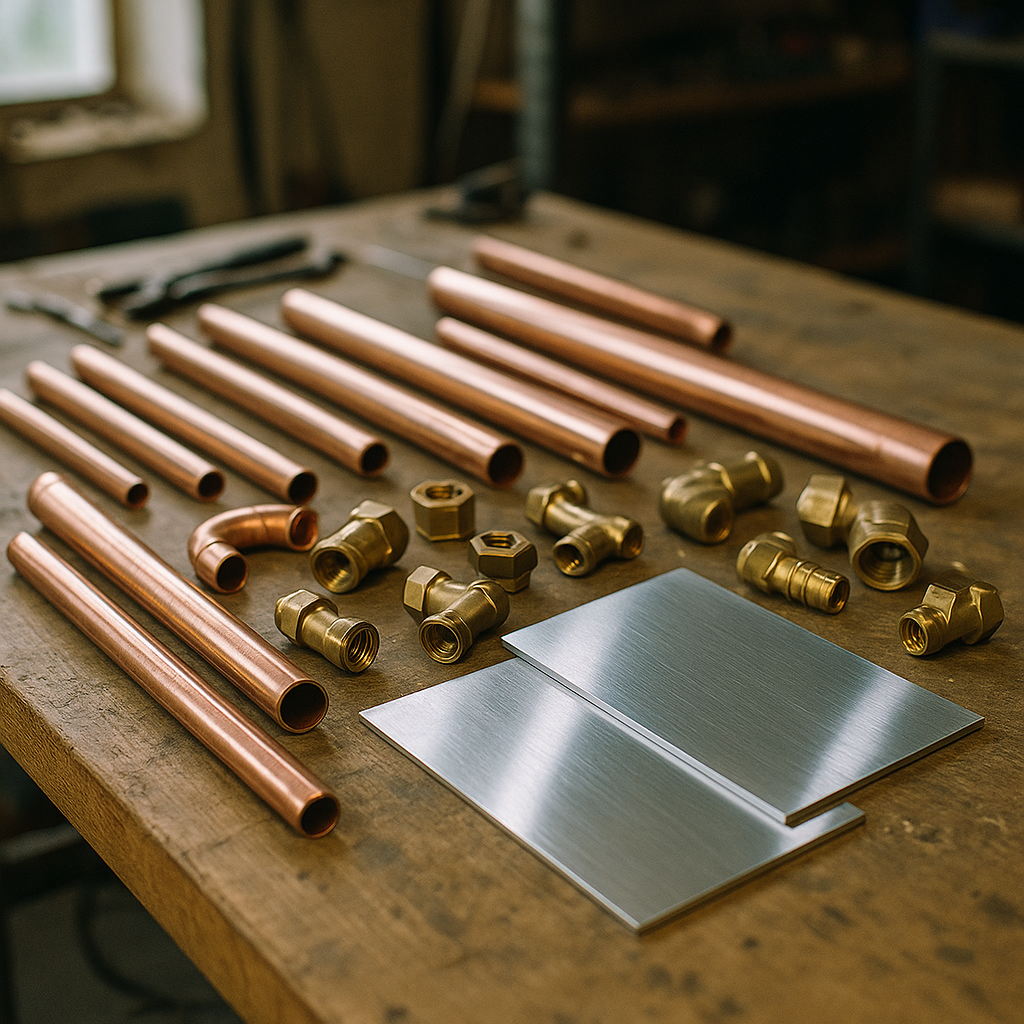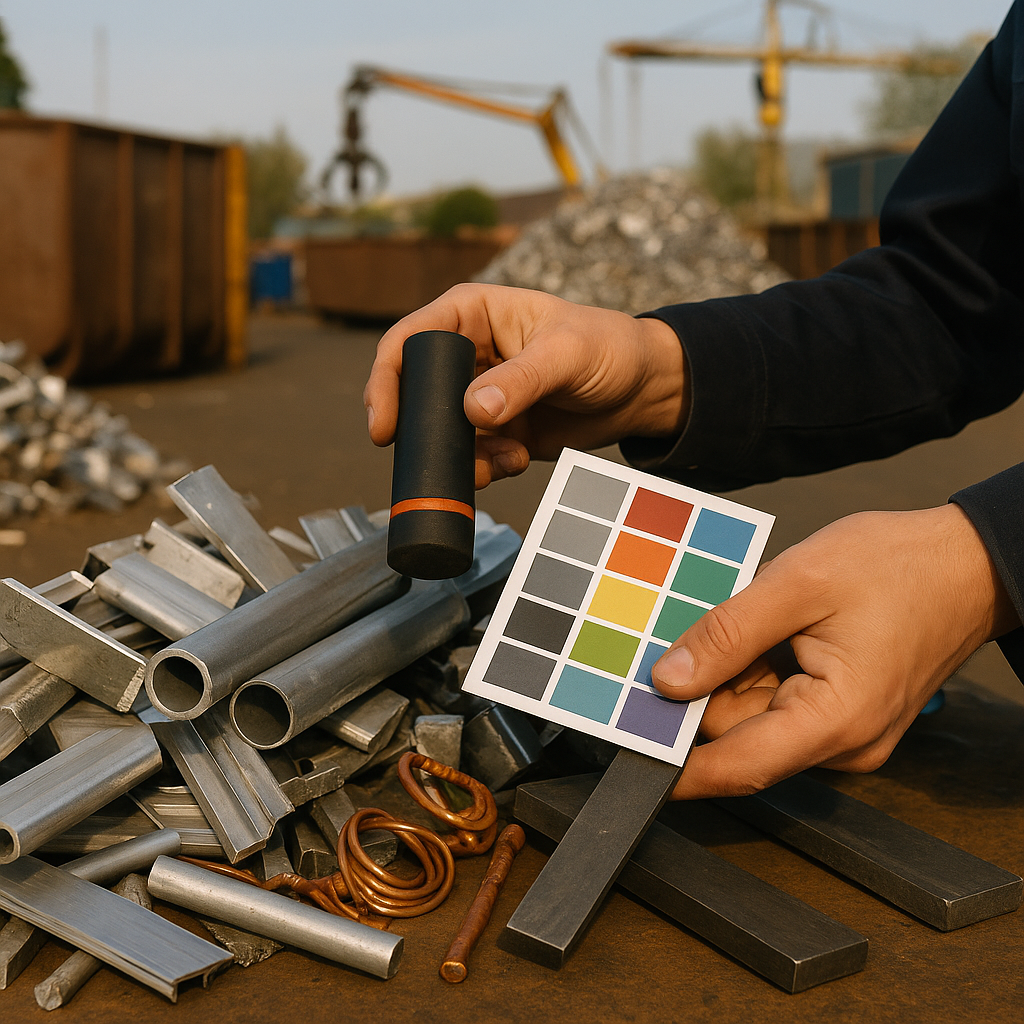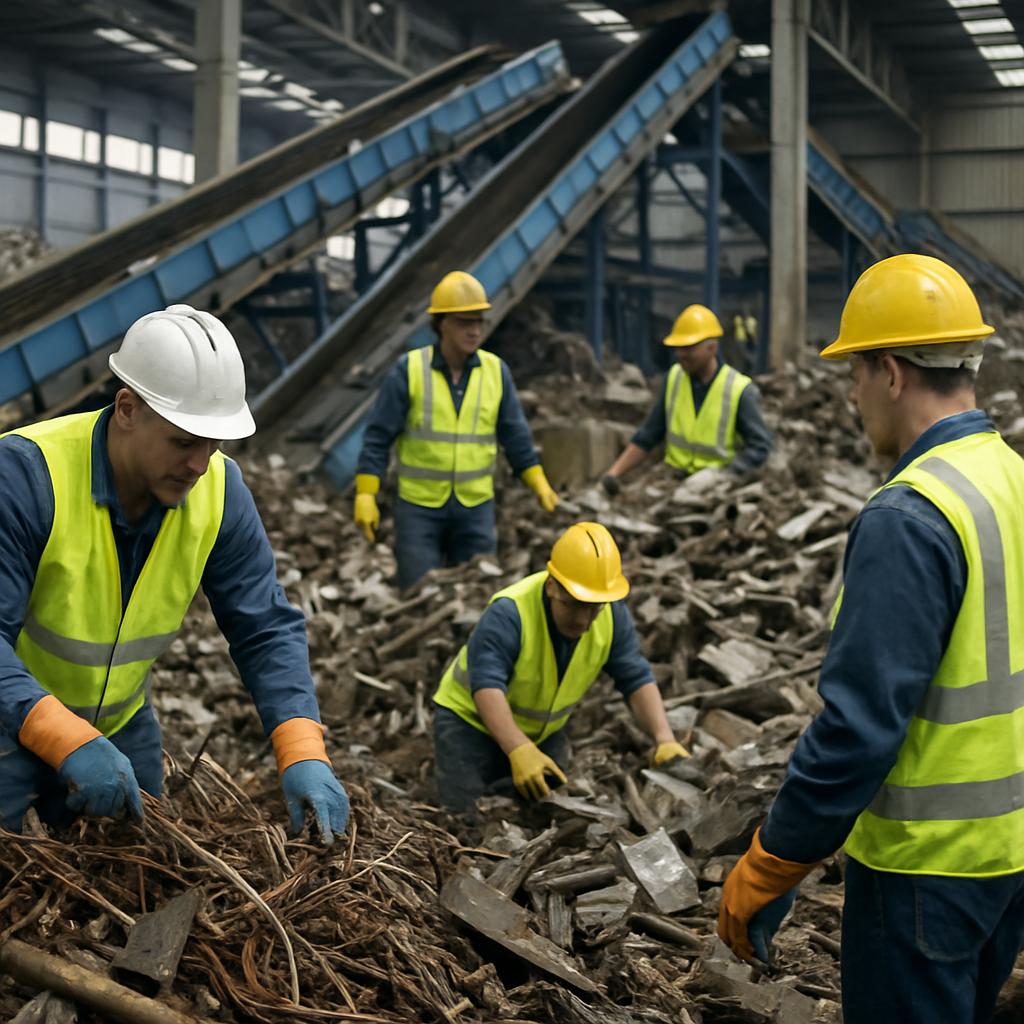5901 Botham Jean Blvd, Dallas, TX 75215
What Are the Types of Metals? Properties, Uses & Examples
September 6, 2025Each day, thousands of tons of metal are recycled across the United States. These valuable materials originate from construction sites, manufacturing facilities, and even household items. Understanding the different types of scrap metal is crucial for effective recycling and maximizing value.
Scrap metals are primarily categorized into two types: ferrous and non-ferrous. This classification forms the foundation for how the recycling industry processes and values these materials. The distinction is simple yet impactful.
Ferrous metals contain iron as their main component. They are magnetic and typically more prevalent in everyday items. In contrast, non-ferrous metals do not contain iron, are not attracted to magnets, and often command higher prices in the recycling market due to their specific properties and relative rarity.
What Are Ferrous Metals and Their Properties?

Ferrous metals are materials that primarily contain iron. The term “ferrous” originates from the Latin word “ferrum,” meaning iron. These metals have distinct characteristics that make them essential in various industries, particularly construction and manufacturing.
The most notable property of ferrous metals is their magnetic nature, which allows for easy identification and separation during the recycling process. Using a magnet can quickly determine if a metal is ferrous or non-ferrous, making sorting more efficient at recycling facilities.
Common Types of Ferrous Metals
Several types of ferrous metals are widely used across industries. Each possesses unique properties suited for specific applications:
Steel is the most commonly used ferrous metal, containing iron with carbon content typically below 2%. It offers excellent tensile strength, durability, and versatility. Different steel varieties exist depending on carbon content and alloying elements added.
High carbon steel provides superior strength and hardness but less ductility. Low carbon steel (mild steel) offers better malleability and weldability. Steel’s combination of strength and relatively low cost makes it invaluable in construction and manufacturing.
Cast Iron contains more carbon than steel (usually 2-4%) and is known for its excellent compression strength and wear resistance. Though more brittle than steel, cast iron performs exceptionally well under compression. Its ability to retain heat makes it popular for cookware, while its durability makes it suitable for pipes, machinery parts, and automotive components.
Wrought Iron is nearly pure iron with minimal carbon content. It’s highly malleable, ductile, and resistant to corrosion compared to other ferrous metals. These properties make it ideal for decorative elements, gates, railings, and outdoor furniture where aesthetic appeal combined with strength is desired.
Key Properties of Ferrous Metals
- Magnetic properties – Attracted to magnets due to their iron content
- High tensile strength – Excellent for structural applications and load-bearing components
- Durability – Able to withstand significant stress and pressure
- Relatively low cost – More economical than many non-ferrous metals
- Susceptibility to corrosion – Prone to rust when exposed to moisture and oxygen (with exceptions like stainless steel)
- Recyclability – Can be melted down and reused without significant degradation
Applications in Everyday Life
Ferrous metals are prevalent in our daily lives. From the moment we wake up until bedtime, we interact with numerous items made from these strong, versatile materials:
- Construction: Structural beams, reinforcement bars (rebar), bridges, and skyscrapers
- Transportation: Car frames, engine blocks, railway tracks, and shipping containers
- Home appliances: Refrigerators, washing machines, and oven frames
- Kitchen items: Cast iron cookware, stainless steel utensils, and sinks
- Tools: Hammers, wrenches, screwdrivers, and garden equipment
- Infrastructure: Pipelines, utilities, and electrical poles
Despite their strength, ferrous metals have one significant drawback: most are vulnerable to rust and corrosion when exposed to moisture and oxygen. This oxidation process forms iron oxide (rust), weakening the metal over time. However, certain alloys, like stainless steel, contain chromium that forms a protective layer, significantly increasing corrosion resistance.
The recycling industry highly values ferrous metals due to their magnetic properties that simplify sorting, and their ability to be melted and reformed without losing integrity. Steel is one of the most recycled materials worldwide, with about 70% being recycled—more than paper, plastic, and aluminum combined.
| Carbon Steel | 0.3% to 2% |
| Cast Iron | 2% to 4% |
| Alloy Steel | Varies (high carbon content) |
| Stainless Steel | At least 10.5% chromium |
| Wrought Iron | Less than 0.08% |
Understanding ferrous metals and their properties is essential for making informed decisions about material selection in construction, manufacturing, and recycling processes. Their strength, versatility, and recyclability ensure they remain fundamental components of our modern infrastructure.
What Are Non-Ferrous Metals and Their Characteristics?

Non-ferrous metals are metallic materials without iron as their main component. Unlike ferrous metals, these are non-magnetic and offer unique properties valuable across numerous industries. Common examples include aluminum, copper, brass, zinc, lead, nickel, and titanium.
The absence of iron gives non-ferrous metals several advantageous characteristics, such as resistance to corrosion and rust. While ferrous metals quickly develop rust upon exposure to moisture and air, non-ferrous metals naturally form oxide layers that protect against environmental damage.
Key Properties of Non-Ferrous Metals
Non-ferrous metals stand apart in several important ways:
- Corrosion Resistance: Without iron, these metals resist oxidation and corrosion, ideal for outdoor applications, marine environments, and plumbing systems.
- Lightweight: Materials like aluminum have exceptional strength-to-weight ratios, weighing about one-third as much as steel while maintaining structural integrity.
- Conductivity: Copper and aluminum offer excellent thermal and electrical conductivity, essential in power transmission and electronics.
- Malleability and Ductility: Many non-ferrous metals can be easily shaped, formed, and drawn into wires without breaking.
- Non-magnetic Properties: Their absence of magnetic attraction makes them suitable for applications avoiding magnetic interference.
These unique properties generally come with a higher cost. Non-ferrous metals typically cost more than ferrous metals due to their rarity and complex extraction processes. Recycling helps offset these costs since many non-ferrous metals can be recycled repeatedly without losing properties.
Common Non-Ferrous Metals and Their Applications
Each non-ferrous metal has distinct characteristics suited to various applications:
Aluminum: Valued for its lightness and corrosion resistance, aluminum is used extensively in aerospace, vehicles, packaging, and construction. Its heat conductivity makes it ideal for heat sinks and cookware.
Copper: Known for the highest electrical conductivity among non-precious metals, copper is vital in electrical wiring, circuit boards, and telecommunications. Its antimicrobial properties are valued in healthcare, and its thermal conductivity is suitable for heat exchangers and plumbing.
Brass: This copper and zinc alloy combines strength with machinability and corrosion resistance. It’s commonly used in plumbing fixtures, musical instruments, decorative items, and marine applications due to its resistance to saltwater corrosion.
Zinc: Used beyond galvanizing steel, zinc serves as a protective coating for other metals and is utilized in die-casting due to its low melting point.
Lead: Despite toxicity concerns, lead’s density and radiation resistance are invaluable in radiation shielding and battery production.
Titanium: Known for its extraordinary strength-to-weight ratio and biocompatibility, titanium is crucial in aerospace, medical implants, and high-performance sports equipment.
Non-Ferrous Metals in Modern Technology
Dramatic increases in demand for non-ferrous metals are being driven by tech advancements and the green energy transition. From smartphones to solar panels, these materials enable technological progress:
Electronics manufacturers depend on copper for circuit boards, aluminum for heat dissipation, and gold for corrosion-resistant connections. Renewable energy systems use a lot of copper for generators and transmission, while electric vehicles rely heavily on aluminum, copper, and specialized non-ferrous alloys.
Medical technology uses titanium and other biocompatible non-ferrous metals for implants and surgical tools. Their non-magnetic nature also makes them suitable for MRI-related equipment.
| Metal | Tensile Strength | Resistance to Rust/Corrosion | Electrical and Thermal Conductivity | Boiling Point | Melting Point | Common Application |
|---|---|---|---|---|---|---|
| Titanium | High | Excellent | Poor | 3287°C | 1668°C | Automotive, aerospace, medical |
| Nickel | High (at elevated temperature) | Excellent | Good | 2913°C | 1453°C | Batteries, energy, electrical, chemicals |
| Copper | Good | Excellent | Excellent | 2595°C | 1083°C | Electronic, energy, construction, tools |
| Aluminum | Medium | Excellent | Good | 2470°C | 660°C | Aerospace, automotive, construction |
| Bronze | High | Good | Excellent | 2300°C | 950°C | Coins, instruments, statues, automobiles |
| Lead | Low | Excellent | Poor | 1749°C | 328°C | Ammunition, batteries, radiation shielding |
| Brass | High | Good | Good | 1100°C | 900-940°C | Plumbing, electrical, aircraft, musical instruments |
| Zinc | Low | Good | Medium | 907°C | 420°C | Solar panels, handrails, car bodies |
The recyclability of non-ferrous metals is crucial for sustainability. Unlike some materials that degrade during recycling, most non-ferrous metals maintain their properties through multiple recycling cycles, reducing the need for environmentally harmful mining operations.
As technological demands evolve, non-ferrous metals become increasingly important. Their unique properties enable innovation across industries, from microscopic electronics to massive architectural structures, demonstrating their versatility and essential role in modern manufacturing.
How Can You Identify Different Types of Scrap Metal?

Accurate identification of scrap metal is essential for effective recycling and maximizing value. The process involves simple tools combined with observing physical properties to determine the type of metal. Let’s explore practical methods that both professionals and homeowners can use to identify different types of scrap metal.
The Magnet Test: Your First Sorting Tool
A simple magnet offers a fundamental and reliable method for initial scrap metal identification, dividing metals into ferrous and non-ferrous categories.
When you place a magnet against a metal surface, a strong attraction indicates ferrous metal (containing iron). Steel, cast iron, and wrought iron exhibit this magnetic pull. The attraction should be immediate and firm with true ferrous metals.
If the magnet doesn’t stick, you’re dealing with non-ferrous metal like aluminum, copper, brass, or bronze. These non-ferrous metals typically command higher prices in recycling markets, making this distinction particularly valuable.
Visual Identification: Color and Appearance
After the magnet test, examine the color and appearance of your scrap metal. Each metal displays distinct visual characteristics:
Copper has an unmistakable reddish-brown color. When exposed to air, it develops a greenish patina. It’s commonly found in electrical wiring, plumbing pipes, and roofing materials.
Aluminum appears silvery-gray with a dull finish and is notably lightweight. Aluminum doesn’t rust like ferrous metals but may develop a whitish oxidation layer when exposed to the elements.
Brass shows a distinctive yellow-gold or brownish-yellow color. This copper-zinc alloy is often used in decorative items, musical instruments, and plumbing fixtures. Depending on its composition, its color can range from bright yellow to a deeper bronze-like hue.
Weight Assessment: Density Differences
The metal’s weight relative to its size provides another valuable identification clue. Assess its weight compared to its volume:
Aluminum feels surprisingly light for its size, a reason it’s favored in applications where weight matters, like aircraft components and beverage cans.
Copper feels noticeably heavy for its size, helping distinguish it from lighter metals like aluminum.
Lead is exceptionally heavy—even small pieces have significant weight, feeling much heavier than expected based on their size.
Surface Texture and Hardness Tests
Examining surface characteristics and testing hardness can further refine identification:
File a small, inconspicuous area of the metal to reveal its true color beneath any coating, paint, or oxidation. The fresh surface often shows the characteristic color more clearly than the exterior.
Test the metal’s hardness by attempting to scratch it with a nail or screwdriver. Aluminum is relatively soft and scratches easily, while steel is much harder to mark. Lead is so soft you can scratch it with your fingernail.
Look for distinctive corrosion patterns. Ferrous metals typically rust (showing reddish-brown oxidation), while copper develops a green patina, and aluminum forms a whitish oxide layer.
Advanced Identification Methods
For more precise identification, especially of specific alloys, more sophisticated methods are available:
Spark testing involves holding the metal against a grinding wheel and observing the pattern, color, and behavior of the sparks produced. Different metals create distinctive spark patterns—steel produces bright, branching sparks while titanium generates intensely bright, white sparks.
Chemical spot tests use reagents that react differently with various metals. These tests can identify specific elements within an alloy by producing characteristic color changes or reactions.
Spectrometers analyze the light spectrum emitted by metals when energized, offering detailed composition analysis. These professional-grade tools can identify precise alloy types and are commonly used in recycling facilities and metal processing plants.
Common Scrap Metals and Their Identification Features
Here’s how to identify some common scrap metals:
Steel: Magnetic, relatively heavy, and typically gray. Often shows reddish-brown rust when exposed to moisture. Found in construction materials, vehicles, and appliances.
Copper: Non-magnetic, reddish-brown, relatively heavy, develops a green patina over time. Common in electrical wiring, plumbing, and electronics.
Aluminum: Non-magnetic, silver-gray, notably lightweight, doesn’t rust but may develop white oxidation. Used in beverage cans, siding, and vehicle parts.
Brass: Non-magnetic, yellow to gold-brown, heavier than aluminum but lighter than copper. Often found in plumbing fixtures, decorative items, and musical instruments.
Stainless Steel: Most grades show weak or no magnetic attraction, silver color with distinctive sheen, resists corrosion. Used in kitchen appliances, medical equipment, and food processing equipment.
Lead: Non-magnetic, dull gray, extremely heavy for its size, very soft. Found in old plumbing, roofing materials, and radiation shielding.
Tips for Accurate Home Identification
For reliable scrap metal identification at home:
Clean the metal surface thoroughly before testing. Remove dirt, grease, paint, or corrosion that might interfere with visual identification or magnet tests.
Use a strong magnet rather than a weak refrigerator magnet. Neodymium magnets provide definitive results for the magnet test.
Keep reference samples of common metals for comparison. Known examples of copper, aluminum, brass, and steel help when identifying unfamiliar pieces.
If in doubt, separate questionable items and seek help from your local recycling facility. Most recyclers are happy to assist with proper metal identification.
Remember that some items contain multiple metal types. Appliances, electronics, and vehicles often require disassembly to separate different metal components for recycling.
Why is Recycling Different Types of Scrap Metal Important?

Recycling different types of scrap metal provides significant environmental and economic benefits beyond just reducing waste. By diverting metals from landfills, we conserve valuable resources and significantly decrease greenhouse gas emissions. Recycling metals requires far less energy than extracting and refining virgin ore, saving 92% for aluminum, 90% for copper, and 56% for steel. This energy efficiency directly reduces carbon footprints and minimizes environmental harm.
The economic benefits of metal recycling are also substantial. The recycling industry contributes nearly $117 billion annually to the U.S. economy and supports over 500,000 jobs nationwide. For businesses and municipalities, recycling scrap metal offers financial opportunities through cost savings and potential revenue. The metal recycling process creates a sustainable cycle where materials retain their value through multiple lifecycles, benefiting both our economy and the environment.
Ready to enhance the value of your scrap metal while supporting environmental sustainability? Contact Okon Recycling at 214-717-4083 for professional recycling solutions tailored to your specific needs.
